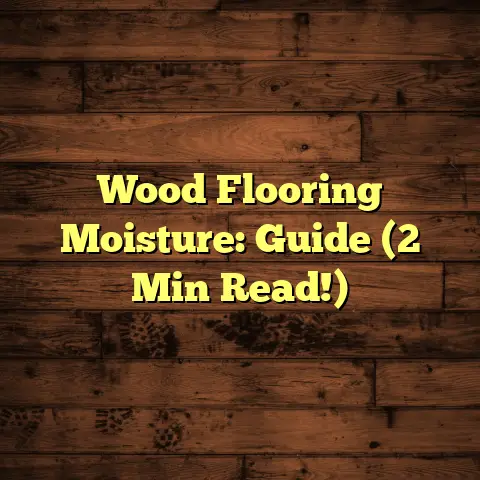Can You Use Murphy Oil On Wood Floors? (Explained)
I once made a big mistake that still lingers in my mind.
I used Murphy Oil Soap on a beautiful oak hardwood floor without doing thorough research first.
The result?
A hazy, sticky mess that took me days to correct.
I learned my lesson the hard way, and now I want to share everything I’ve discovered about using Murphy Oil on wood floors, so you don’t have to go through the same ordeal.
Understanding Murphy Oil Soap
Murphy Oil Soap is often marketed as a versatile cleaner for various surfaces, including wood floors.
It’s known for being effective in removing dirt and grime while leaving a pleasant scent.
But is it suitable for all types of wood flooring?
This is where things get a bit tricky.
My Experience with Murphy Oil Soap
When I started in this field, I was eager to try every product I came across.
One day, after hearing rave reviews from friends, I decided to use Murphy Oil on my own home’s wooden floors.
The floors looked great initially, but soon after, I noticed a buildup of residue.
No matter how much I scrubbed, the haze remained.
I did some digging and found out that while many professionals recommend using it for certain finishes, it may not be ideal for all types of wood flooring, particularly those with polyurethane finishes.
My advice?
Always check your floor’s finish before using any cleaner.
Types of Wood Floor Finishes
Understanding the type of finish on your wood floor is crucial before deciding on a cleaner.
Here’s a quick rundown of common finishes:
- Polyurethane: This is the most common finish.
It’s durable and water-resistant but can be sensitive to certain cleaners. - Oil-based finishes: These require special care and specific products for cleaning and maintenance.
- Wax finishes: These can be damaged by water and some cleaning products, including Murphy Oil.
Knowing your finish can save you from making costly mistakes.
How to Use Murphy Oil Soap Safely
If you’re determined to use Murphy Oil on your wood floors, here’s how to do it safely:
- Dilution is Key: Always dilute Murphy Oil Soap with water according to the instructions on the bottle.
This minimizes the risk of residue buildup. - Test First: Pick a small, inconspicuous area of your floor to test the cleaner.
Wait for a few hours and check for any adverse reactions. - Microfiber Mop: Use a microfiber mop instead of a traditional mop.
This helps in reducing excess moisture on your floors. - Rinse: After cleaning with Murphy Oil, follow up with a damp mop using clean water to remove any excess soap.
- Dry Thoroughly: Ensure that your floors are completely dry after cleaning to prevent any water damage.
Comparing Alternatives to Murphy Oil
In my experience, there are several alternatives to Murphy Oil that work just as well—if not better—depending on your floor type.
Vinegar and Water Solution
I’ve used a vinegar and water solution for years, especially on polyurethane-finished floors.
Just mix one cup of white vinegar with one gallon of warm water.
It’s effective in cutting through grime without leaving residue.
Pros:
- Easy to make.
- Non-toxic and safe.
Cons:
- The smell can be strong until it dries.
pH-Balanced Wood Cleaners
These cleaners are formulated specifically for wood floors.
I’ve found brands like Bona or Method to be effective and easy to use.
Pros:
- Designed for different wood finishes.
- Usually leave a nice shine without residue.
Cons:
- Can be more expensive compared to DIY solutions.
Coconut Oil-Based Cleaners
Recently, I’ve experimented with coconut oil-based cleaners, which have provided excellent results without any sticky residue.
The natural properties of coconut oil help nourish the wood while cleaning it.
Pros:
- Eco-friendly.
- Leaves a subtle sheen.
Cons:
- Can be more costly than traditional cleaners.
Costs and Estimation in Flooring Projects
When it comes to flooring projects, cost estimation can be daunting.
That’s where tools like FloorTally come into play for me.
The platform allows me to input various factors like room dimensions, type of flooring material, and labor costs.
For example, when tackling a recent project in a friend’s 1,200 square-foot home, I used FloorTally to estimate that the installation of engineered hardwood would cost around $8 per square foot including materials and labor.
This helped me provide a realistic budget upfront and avoid any hidden costs later on.
Breaking Down Costs
Let’s take a closer look at how FloorTally assists in breaking down costs:
- Material Costs: Depending on whether you’re using hardwood or laminate, prices can vary significantly.
For instance, quality hardwood can range from $5 to $15 per square foot, while laminate might fall between $1 to $5 per square foot. - Labor Costs: Labor can take up a significant part of your budget, often ranging from $2 to $5 per square foot for installation.
- Additional Expenses: FloorTally also allows consideration for additional expenses like underlayment, moldings, and waste factors—something I’ve often overlooked in past projects.
- Hidden Costs: FloorTally emphasizes the importance of accounting for hidden costs associated with removing old flooring or repairing subfloors—this has saved me from underquoting in many instances.
Maintenance Tips for Wood Floors
Keeping your wood floors in pristine condition goes beyond just cleaning.
Here are some tips based on my years in the industry:
- Regular Dusting: Use a soft broom or vacuum designed for hard floors weekly to prevent scratches from dirt and debris.
- Immediate Spills: Wipe up spills immediately to avoid stains or damage.
- Avoid Excessive Water: Never mop with soaking wet mops; this can warp your wood over time.
- Protective Pads: Use felt pads under furniture legs to prevent scratches when moving furniture around.
- Professional Refinishing: Consider refinishing your floors every 5-7 years depending on wear and tear.
Seasonal Maintenance
I’ve also found that maintaining wood floors varies by season:
- Winter: During colder months, use a humidifier if your home gets dry.
This helps prevent wood from shrinking or cracking due to low humidity levels. - Summer: Keep blinds closed during peak sunlight hours to prevent discoloration and fading from UV rays.
Real-Life Anecdote: A Lesson Learned
I remember one particular project where I decided to experiment with different cleaners on my client’s bamboo flooring.
I used Murphy Oil on one room and a pH-balanced cleaner in another.
The difference was stunning!
The room cleaned with Murphy had a sticky residue after drying, while the pH-balanced cleaner left the floor looking fresh and clean.
My client noticed too, and it turned into an opportunity to educate her about proper maintenance for her bamboo floors moving forward.
Additional Considerations When Using Cleaners
When selecting cleaners, consider these additional factors:
Environmental Impact
As someone who values eco-friendly choices, I’ve started choosing products that have minimal environmental impact.
Brands that use biodegradable ingredients are becoming increasingly popular for good reason.
Allergies and Sensitivities
If you or someone in your home has allergies or sensitivities, consider using fragrance-free cleaners or those specifically formulated for sensitive individuals.
Long-term Effects on Wood Finish
Some cleaners can strip away protective coatings over time, leading to increased wear on your floors.
It’s something I learned through trial and error; always check labels for compatibility with your floor finish.
Cleaning Frequency
How often should you clean your wood floors? From my experience:
- Daily: Light sweeping or vacuuming is essential to keep dirt at bay.
- Weekly: A more thorough cleaning with a damp mop or appropriate cleaner should be done weekly.
- Monthly: Consider deep cleaning once a month using a specialized product suitable for your floor type.
- Annually: An annual professional cleaning can help restore the shine and quality of your floors without causing damage.
Understanding Wood Floor Installation
I often get asked about the installation process when discussing maintenance tips.
Here’s what you should know:
Preparation
Before installing new flooring, it’s vital to prepare the subfloor properly. This includes:
- Leveling the Surface: Uneven subfloors can cause issues down the line.
- Moisture Testing: Certain types of flooring require moisture testing before installation to avoid future problems.
- Acclimation: Allowing wood planks to acclimate in the room where they will be installed is essential for preventing warping or shrinking later on.
Installation Methods
Based on my experience, there are several installation methods available:
- Nail Down: Commonly used for solid hardwood; provides a strong bond but requires more equipment.
- Glue Down: Often used for engineered wood; generally easier but can be messier.
- Floating Floors: A DIY-friendly method where planks lock together without adhesives or nails; suitable for many types of engineered flooring.
Troubleshooting Common Issues
Even with the best care practices, problems can arise with wood floors.
Here are some common issues I’ve encountered and how you can address them:
Scratches and Dents
Solution: For light scratches, I often recommend using a touch-up marker or crayon that matches your floor color.
For deeper dents, sand down the area lightly and apply matching stain before sealing it again.
Water Damage
If you notice warping or cupping due to water exposure:
- Act Quickly: Remove any standing water immediately.
- Dry the Area: Use fans or dehumidifiers to dry out the affected area.
- Assess Damage: If damage persists, consult a professional who can assess whether repair or replacement is necessary.
Fading or Discoloration
To combat fading:
- Use Rugs or Mats: Place them at entry points to absorb dirt and protect high-traffic areas.
- UV Film on Windows: Installing UV film can help reduce sun exposure and fading over time.
Long-Term Care Strategies
As someone who has spent years in this industry, I can’t stress enough the importance of long-term care strategies for preserving wood floors:
- Regular Inspections: Check for signs of wear regularly so you can address issues before they become major problems.
- Re-Coating Services: Consider hiring professionals every few years for re-coating services which refreshes the protective layer without full refinishing.
- Educate Your Family: Make sure everyone understands how to care for the floors—from removing shoes at the door to avoiding certain cleaning products.
Conclusion: Choosing Wisely
So, can you use Murphy Oil on wood floors?
Yes, but with caution!
Always consider your floor’s finish and follow proper usage guidelines if you choose to go this route.
However, don’t forget there are other effective alternatives that might suit your needs better without the risk of buildup or damage.
Choosing the right product can make all the difference in how your wood floors look and feel.
If you’re ever unsure, reaching out to flooring professionals can provide tailored advice based on your specific situation.
By sharing my experiences and lessons learned over the years, I hope you feel more equipped to care for your wood floors effectively and confidently!





